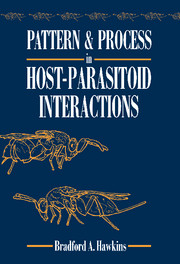1 - Introduction
Published online by Cambridge University Press: 04 May 2010
Summary
Insect parasitoids, their phytophagous hosts and their hosts' foodplants compose a major proportion of the world's biodiversity. Based on the current numbers, organisms directly involved in plant–insect–parasitoid interactions represent well over half of all known species (Price, 1980; Strong, Lawton & Southwood, 1984). Of course, the bulk of species remains undescribed, but even if and when a complete global inventory of species is available, plant–insect diversity will still dominate the biota (World Conservation Monitoring Centre, 1992). Given the staggering number of species involved, host–parasitoid interactions can be expected to be exceedingly complex, and virtually any conceivable type of relationship between parasitoids and their hosts can probably be found to exist. The massive literature that has already been generated provides just a taste of complexities remaining to be discovered, and dealing with this diversity presents population and community ecologists with a daunting task. If we accept that understanding host–parasitoid interactions is an important undertaking worth the time and resources it will clearly require, what are our options for achieving this understanding?
One extreme is to pursue a case–specific approach, in which a few model systems are developed, and the fine details worked out through observation and experimentation. If we pick our systems carefully, this will provide us with a strong foundation for understanding at least some of the range of possible interactions.
Information
- Type
- Chapter
- Information
- Publisher: Cambridge University PressPrint publication year: 1994
